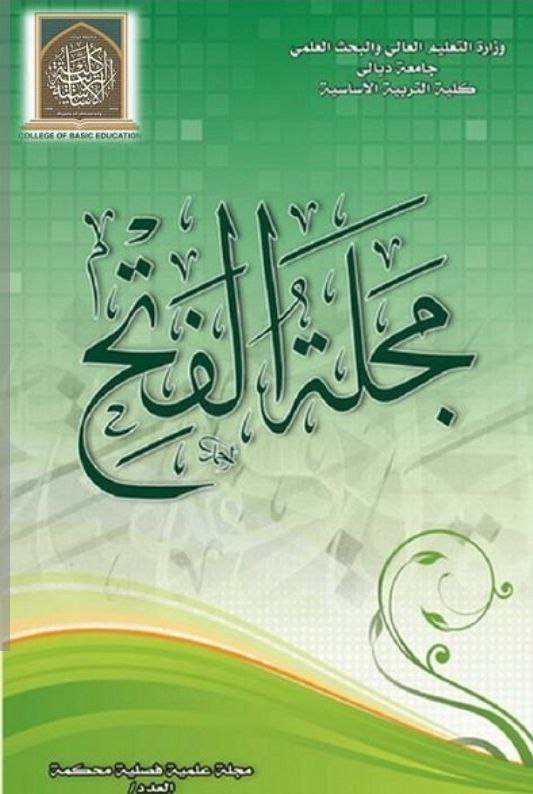The effect of group competition style exercises on learning dribbling, handling and ball retention skills
Abstract
The first chapter of this study is an introduction and the significance of
the study in learning the skills of rolling, passing and keeping the ball in
football using the method of group competition. The problem that this
study addresses is the lack of the use of this method in teaching the skills
of football in the curriculum of the first grade in the College of Physical
Education, University of Diyala. The aim of the study is to investigate
the effect of using group competition in learning those skills on the
students of the first grade in the College of Physical Education,
University of Diyala. The second chapter dealt with the theoretical
framework of the study and the skills chosen in the study as well as
similar studies.
The researcher used the experimental method in the study on a sample of
20 students of the first grade with 12 educational units 90 minutes each.
The fourth chapter included the results in charts that were analyzed and
discussed using the proper scientific and statistical methods.
In the light of the results of the study, the researcher reached at the
following conclusions:
1. Group competition has a positive effect on learning rolling,
passing, and keeping the ball in football.
In the light of conclusions, the researcher recommended the following:
1. The use of group competition in learning other skills of football
with different age groups.
2. Conducting the same study on different sports.
3. Studying the effect of other methods on learning the basic skills in
football.
References
ثض١ٕخ ػجذ اٌخبٌك ؛ رؤص١ش اعٍٛة اٌ زؼٍُ اٌزٕبفغ ٟ ف ٟ اٌزؾص ١ ًاٌّؼشف ٟ ٚاالداء اٌّٙ بسٞ
ٚاالٔغ بص ٌفؼبٌ١ خ سِ ٟ اٌم شح )ثؾ ش ِٕش ٛس, وٍ١ خ اٌزشث١ خ االعبع ١خ, عبِؼ خ د٠ بٌٝ, ِغٍ خ
اٌفزؼ,0260. )
ؽغٓ ع١ذ ِؼٛض ؛ وشح اٌغٍخ ٌٍغّ١غ . اٌمب٘شح : داس اٌفىش اٌؼشثٟ ، 6002.
ػجبط اؽّذ ص بٌؼ : غشائ ك اٌز ذس٠ظ ف ٟ اٌزشث١ خ اٌش٠بظ ١خ, غ0 .اٌّٛص ً: داس اٌىز ت
ٌٍطجبػخ ٚإٌشش, 0222.
ػجذ ػٍٟ ٔص١ف، ٚلبعُ ؽغٓ ؽغ١ٓ؛ ِجبدئ ػٍُ اٌز ذس٠ت اٌش٠بظ ٟ ، غ6 . اٌّٛص ً :
داس اٌىزت ٌٍطجبػخ ٚإٌشش، 6000.
ػذٔبْ ػجذ اٌىش٠ِ ُؾّٛد ؛ اصش اعزخذاَ اعٍٛة اٌزؼٍُ اٌزؼبٟٚٔ فٟ رؾص١ ًغالة
اٌصف اٌشاثغ اٌؼبَ فٟ ِبدح االدة ٚإٌصٛح . سعبٌخ ِبعغز١ش ، وٍ١خ اٌزشث١خ / اثٓ سشذ ،
عبِؼخ ثغذاد ، 0223.
غبدح ِؤ٠ذ شٙبة ؛ رصّ١ ُاٌؼبة صغ١شح ثبعزخذاَ اعبٌ١ت اٌزٕبفظ ٚ رؤص١ش٘ب ف ٟ رط ٛ٠ش
ٚاؽزفبظ ِغزٜٛ االداء اٌفٕٟ ٚاٌزفى١ ش االث ذاػٟ ػٍ ٝ ثغ بغ اٌؾشو بد االسظ ١خ ف ٟ اٌغّٕبع زه
)اغشٚؽخ دوزٛساٖ ,وٍ١خ اٌزشث١خ اٌش٠بظ١خ ,عبِؼخ ثغذاد ,0220 )ح31.
لبعُ ٌضاَ صجش؛ ِٛظٛػبد فٟ اٌزؼٍُ اٌؾشوٟ . ثغذاد : عبِؼخ ثغذاد، 0225.
ٌّٝ اٌش١خٍٟ ؛ رؤص١ش اعٍٛثٟ اٌزٕبفظ اٌزارٟ ٚاٌغّبػٟ ٌزٚٞ االعزمالي ِمبثً االػزّبد
ػٍٝ اٌّغبي االدساوٟ فٟ رؼٍُ ٚاؽزفبظ ثؼط اٌّٙبساد االعبع١خ ثىشح اٌطبئشح.)اغشٚؽخ
دوزٛساٖ وٍ١خ اٌزشث١خ اٌش٠بظ١خ ٌٍجٕبد ,عبِؼخ ثغذاد ,0221.)
دمحم اؽّذ عٍ١ّبْ ؛ اصش رؼٍ١ ُاٌّجزذئ١ ٓفٟ وشح اٌ١ذ ثبعزخذاَ غش٠مخ إٌّبفغبد اٌغّبػ١خ .
ِغّٛػخ سعبئً اٌّبعغز١ش ٚاٌذوزٛساٖ فٟ اٌزشث١خ اٌش٠بظ١خ . ثغذاد : ِطجؼخ اٌشٚاد ، 6006.
دمحم ؽغٓ ػالٚٞ؛ ِذخً ف ٟ ػٍ ُ اٌ ٕفظ اٌش٠بظ ٟ,غ6 .اٌم ب٘شح : ِشو ض اٌىز بة ٌٍٕش ش,
. 6000
دمحم صجؾٟ ؽغبٔ١ٓ؛ اٌم١بط ٚاٌزمٛ٠ ُفٟ اٌزشث١خ اٌجذٔ١خ، غ3 ،ط6. اٌمب٘شح: داس اٌفىش
اٌؼشثٟ، 6005.
ِ صطفٝ اٌغب٠ؼ دمحم ؛ ارغب٘بد ؽذ٠ضخ فٟ رذس٠ظ اٌزشث١خ اٌجذٔ١خ اٌش٠بظ١خ، غ . اٌمب٘شح:
ِطجؼخ االشؼبع اٌفٕ١خ ، 0226.
ِ فزٟ إثشا٘١ ُ؛ اٌذفبع ٌجٕبء اٌٙغَٛ فٟ وشح اٌمذَ. اٌمب٘شح: داس اٌفىش اٌؼشثٟ،6002.
ٔ ج١ِ ًؾّٛد شبوش؛ ِؼبٌُ اٌؾشوخ. اٌش٠بظ١خ ٚإٌفغ١خ ٚاٌّؼشف١خ، غ6. اٌؼشاق: ِطجؼخ
اٌّزٕجٟ، 0221.
ٚ ع١ِ ٗؾغٛة ؛ غشائك اٌجؾش اٌؼٍّٟ ِٕٚب٘غٗ . اٌّٛصً: داس اٌىزت ٌٍطجبػخ ٚإٌش ش،
.6000
انًصبدر األجنبُت:
Samnclson , Boh . Back to the Bcginning Avcom bublishing ( vol .
swo, I . V . S . A . 1997 ).
Schmidt , A. Richard , and Tiothy , D.Lee : Motorcontrol and
learning : ( 3 rded , Human kinetics , 1999 ) ..
Downloads
Published
How to Cite
Issue
Section
License
Copyright (c) 2023 ليث ابراهيم جاسم، احمد سعد خليل

This work is licensed under a Creative Commons Attribution 4.0 International License.
حقوق النشر والترخيص
تطبق مجلة الفتح للبحوث التربوية والنفسية ترخيص CC BY (ترخيص Creative Commons Attribution 4.0 International). يسمح هذا الترخيص للمؤلفين بالاحتفاظ بملكية حقوق الطبع والنشر لأوراقهم. لكن هذا الترخيص يسمح لأي مستخدم بتنزيل المقالة وطباعتها واستخراجها وإعادة استخدامها وأرشفتها وتوزيعها ، طالما تم منح الائتمان المناسب للمؤلفين ومصدر العمل. يضمن الترخيص أن المقالة ستكون متاحة على نطاق واسع بقدر الإمكان وأن المقالة يمكن تضمينها في أي أرشيف علمي.
لمزيد من المعلومات، يرجى متابعة الرابط: https://creativecommons.org/licenses/by/4.0/.



